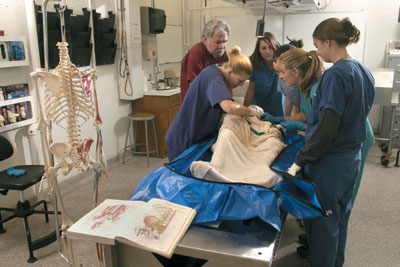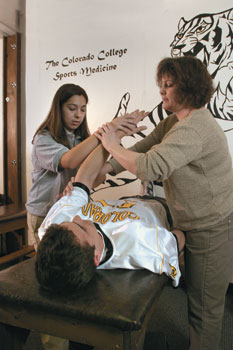




| From Liberal Arts to Healing Arts | |
| By Peter Rice ’05 Photos by Tom Kimmell |
Preparing students for medical professions
When cowboys break themselves at the rodeo — and this is all but guaranteed — Elise Hiza ’06 wants to be the one who stitches them back together. Her career goal is to become an orthopedic surgeon with the Justin Healers, a team of elite doctors and trainers attached to the professional rodeo circuit, thus marrying two of her passions: sports medicine and Western life.
 |
| Pre-medicine, pre-physical therapy, pre-nursing, and sports medicine students work on a human cadaver as part of their training in anatomy. From left, Elisabeth Storrud ’05, Sports Science Lecturer Bruce Kola, Meryl Wolff ’08, Megan Berry ’08, Elise Hiza ’06, and Laura Morgan ’06. |
Her future patients are one-of-a-kind too. “You’ve kind of got to understand the cowboy mentality,” she says. “The recent world champion bull rider rode 10 rounds with a broken hand. They’re a different breed of person.”
Hiza is well on her way to making her dream job a reality. She traveled to Dallas in January with CC Sports Sciences Lecturer Bruce Kola to meet and job shadow the Justin Healers’ head orthopedic surgeon, a friend of Kola’s. Other networking trips to Alberta, Arizona, Montana, and Nevada are planned.
Hiza is just one of dozens of current CC students on track to join hundreds of alumni in the medical field. Every year, 40-50 students or alumni apply to medical school, and roughly 60 percent make it in — that’s 10 points above the national average. Another 20 percent make it on the second try. CC students have attended medical schools at the Mayo Clinic, Harvard, Yale, the University of Colorado, the University of Pennsylvania, and the University of Washington.
It’s all the more impressive considering that CC doesn’t have a “pre-med” major. Biology Professor Lamont Anderson, who advises students planning to join the health professions, chafes at the very term. “This isn’t a holding pattern,” he says. “We aren’t training students to be doctors. We’re training them to be educated people.”
But if students want to shape their education to enter medicine, that’s just fine with Anderson. In fact, he says, “Medical schools have a strong preference for broadly educated individuals.” Students headed in that direction must take courses including general chemistry, organic chemistry, math, physics, and English. Most major in biology or another natural science, but some have majored in political science and even art history.
CC can also be an asset to future medical professionals, according to alumni, because curricular intensity at medical schools is on par with the Block Plan.
Dr. Marion Berg ’84, who practices emergency medicine and teaches at the University of South Alabama Medical Center, decided as an undergrad to go to medical school, then settled on a geology major. Why? He enjoyed it! “I’m glad that I went to a liberal arts college, that I have an intellectual interest in something that has little to do with my current career,” he says. The unusual major even helped him get into the University of South Alabama College of Medicine: When an interviewer asked why he majored in geology, Berg responded, “Because I want to specialize in kidney stones and gallstones.”
“The Block Plan made med school easy,” says Justine Crowley ’94, currently doing her orthopedics
residency at St. Anthony Hospital in Oklahoma City. In one class, “Everybody but me was worried about the first anatomy test because it was ‘only’ 14 days into the semester!”
Of course, taking a subject like organic chemistry in 3½ weeks is never easy, but students say it’s doable, partly because there are no conflicts over lab classes. “I like the fact that the classes are so small. I think it really helps out,” says Jacob Merrell ’05, a biochemistry major from Cheyenne, Wyo., who hopes to become a general practitioner in a rural area.
 |
| Students interested in sports medicine and physical therapy get hands-on practice by working on student athletes under the guidance of CC medical staff. “They’re using the training room as practical experience,” says Cindy Endicott ’93, an associate athletic trainer. Above, Endicott helps Nicole Reyes ’05 perform proprioceptive neuromuscular facilitation on the shoulder of CC lacrosse player Cooper Green ’07. |
CC is also unique in offering students the chance to study the human organism with human cadavers, according to Kola. “We’re the only one of the 30 schools we compare ourselves to that offers cadaver-based human anatomy and physiology,” he says. One class, capped at five students, observes live surgeries at area hospitals, many of them arranged through local doctors Rick Pfeiffer ’84 and Tom Mahony ’67.
Kola says CC is the only school he knows of that offers that opportunity, adding, “Medicine requires real-world experience.” Allison Bukowski ’99, now attending the Kirksville College of Osteopathic Medicine, agrees: “The training room at CC was really progressive. Heading into the medical world, I had already seen a lot of what sports medicine is heading toward.”
But before full-time, real-world experience, there is the long process of getting into a health professions graduate school. That’s always difficult, but the college does what it can to make it a little easier. The health professions office, run by Anderson and staff coordinator Kate Cornelius, helps students gather the necessary paperwork and stay on top of deadlines.
Peer-to-peer support comes through a student group dubbed “Club Med.” Marnita Rodriguez ’05, the co-chair of the group, says one of its goals is to get medically oriented students together to compare notes, especially about the more challenging classes.
“I’d talk to people who’d already took orgo, and they’d give me hints on how to get through it,” she says. “If you’re having a hard time, you’re probably not the only one.” The group also organizes occasional speakers; last year, it held a benefit concert that raised $1,500 for children with cleft palate.
The Colorado College | 14 East Cache La Poudre Street | Colo Sprgs, CO | 80903 || 719-389-6000